In a February 2006 test of four handguns, our Idaho staff called the Walther P22 22 LR No. WAP22003, $301, an “Our Pick.” The test team said, “We liked this little .22 pistol immensely. It was completely reliable in our limited shooting, and shot very well, with many five-shot groups going around an inch at 15 yards. The impact could be fine-tuned as necessary by changing the front sight. The windage was slick and handy, we found, and adjusted with relative ease.… We think anyone in need of a fine little .22 pistol that works every time and doesn’t bust the bank need look no farther than the short-barrel P22. We thought it was an ideal fun gun, one we’d take in the backpack and not even know it’s there.” Then, in the May 2010 issue, we wrote, “Our Team Said: The unanimous decision was that the P22 was the top performer in our tests.…”
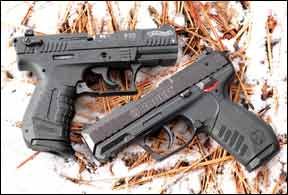
This is a difficult trick to manage for any handgun, because differing ammo selections, test conditions, individual pistol variations, and matchups can magnify the flaws found in any product, making it hard to get a top grade again and again.
But when a gun does that well over time, it can serve as a benchmark against which to test newer products, which in this case is the Ruger SR22PB Model 03600, $399. Like the Walther P22 WAP22003, now $379, Ruger’s SR22 is full of angles and bumps and slots, but not so many serrations. The top of its anodized slide was smooth and semi-gloss, instead of the Walther’s dead-flat black with longitudinal serrations. What would have impressed us mightily is if Ruger (or Walther) had attempted to copy the original Walther PPK for the 22LR, and brought it off nicely at a good sale price. No one makes that gun today, so far as we know. (If Ruger or Walther decided to do it, we suspect a great many fans of James Bond would buy the guns just for the fact that they look like the famous PPK. And if this hypothetical gun were far more accurate than either of these two test guns, we’d beat a path to the maker’s door and buy one for ourselves.) But that veers off our current topic, which is pitting the two similar 22 autoloading pistols head to head.
We acquired a new Ruger and borrowed a locally owned, new-condition P22 for this test. We tested with five types of ammunition. These were CCI Green Tag Competition, Eley’s Match EPS, CCI Mini Mag solids, Winchester Power Point HP, and Federal Classic High-Velocity. How does the new Ruger stack up against the Walther P22? Let’s take a look feature by feature:
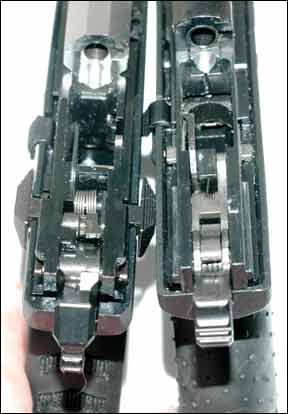
Walther P22 Model WAP22003 22 LR, $379
Walther also has a version with a longer barrel, and one with an integral laser sight for $479. The Walther P22 is full of tactile surprises. The gun is covered with serrations, angled metal and plastic, notches, grooves, and on the grip, pebble-graining. It’s a delight to the eye, very busy yet business-like in its look.
The controls are simple and straightforward. There’s the trigger, with a useable DA and pleasant SA pull. There’s the ambidextrous safety, and though it operates in a reverse direction from that of many popular guns, it’s intuitive after a few seconds. Align it with the barrel and you’re ready to shoot. Move it down to the safe position and the hammer moves back a touch if it’s down, but doesn’t drop if it’s cocked. The safety blocks the hammer from striking the firing pin, and also locks the firing pin so the gun can’t discharge. If the hammer is cocked, putting the safety on leaves it cocked. You can lower the hammer by grasping it firmly with thumb and index finger on its sides, and pressing the trigger. Or if you’re lazy, just press the trigger with the gun pointed in a safe direction. We don’t recommend that method. Although the gun can be carried cocked and locked, it’s not a convenient safety for that purpose.
Another control is the slide lock, which holds the slide rearward after the last shot. Next is the ambidextrous magazine release, which is a latch device at the bottom rear of the trigger guard that you press downward to release the magazine. One reader wrote that he had trouble keeping the magazine in the gun whilst wearing gloves, or with a shooter who had fat fingers. We submit that handguns ought never to be fired with gloves. While one of us was in Alaska running a trap line, the handgun was kept warm in a shoulder holster. That trapper always removed his gloves to shoot, even at 40 degrees below zero. As for the mag dropping out of the Walther, we could not get it to come out accidentally no matter how thick a glove we wore, nor by pressing down hard on the release with our trigger finger inserted. We suspect that reader either had dirt fouling the latch or a faulty latch on his Walther. We generally used a finger on each side of the mag release to get the mag out of the gun.
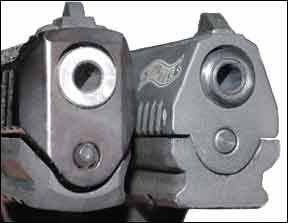
Two magazines came with our test gun, one with a flat bottom and one with a PPK-like extension. However, the latest information is that only one magazine comes with the gun. Each held ten rounds. One more control on the P22 is the takedown latch near the front of the trigger guard, which requires you to first clear the gun, then press downward on this saddle-like latch until it drops out of the way. Then pull the slide to the rear, lift it, and ease it forward off the barrel. This is similar to the takedown for the PPK, but the recoil spring is not around the barrel here, it’s on a small rod that falls out when you remove the slide. That’s the weak point of this design, because you need a “tool” in the form of a slave rod to capture the spring before you can reassemble the gun. It may be possible to do so without that tool, but we could not do it. That’s where Ruger has an advantage, which we’ll look at in a moment.
There’s also a rail under the muzzle for a light, sort of a Picatinny rail, with one notch. A variety of lights can be put on there, but we fail to see the need for a light on a 22 handgun. A laser sight there might make some sense for those with compromised vision.
Walther makes it easy to install a silencer-threaded barrel where those are legal. Or you can change the barrel for a longer one, at extra cost for the extra parts. The sights are plastic, the front bearing a numeral 3, and the rear having a windage adjustment. The gun shot a touch low for us, so we elected to change the front sight. Three sights came with the gun, numbered 2, 3, and 4. We chose number 2. Removing the original sight was easy by poking it out with a screwdriver from the inside, with the gun being disassembled. Getting the new sight in was tricky. We finally put it in location and rapped it with a stick, and in it went. Then our shots were where we wanted them on the 15-yard target. Windage was easy to correct with the screw-adjustable rear sight. The sight picture was excellent, and had three white dots. If we were picky, we’d have the rear notch a tad narrower, but as it was it was fast to use.
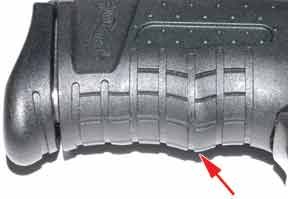
Besides, the three front-sight inserts, there was also a flat insert for the back of the grip, and we chose to change it out. A slight press with hand pressure on a proper-size punch got out the rear grip’s retaining pin, and we easily installed the flatter housing. There was also a key in the package to lock the gun, the slide-spring installation rod, and a wrench to remove the barrel.
With the gun apart, we found excellent workmanship inside. The slide is aluminum alloy, as is the barrel-retention block and the slide rails inside the frame. Everything looked good, we took our pix, and it was time to reassemble the P22. We found that inserting the slave rod through the hole in the front of the slide was the easiest. Then with the recoil spring and rod in place in the frame, we fit the forward part of the recoil spring around the slave rod, inserted the barrel in its hole, and the gun went together easily. We suspect Walther could modify this setup to match that use by Ruger, to eliminate the need for the slave rod.
On the range we had no problems with the gun except with the Federal Classic ammo. This gave repeated failures to cycle the slide far enough to pick up the next round. The same thing happened with the Ruger. We had an occasional failure to fire, caused by some of our test ammo being quite old. It also had failed to fire in the past in other good guns. The simple fix was to cycle the hammer again with the DA trigger on the P22. Again the same thing happened with the Ruger. Bad ammo is bad ammo.
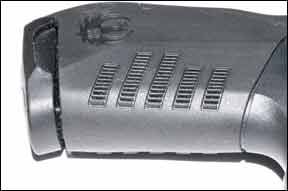
We wanted more accuracy than we got. With our No. 2 front sight, the gun shot just above the point of aim at 15 yards, which is what we wanted. The final choice of front sight would depend on the final selection of the very best ammo for the gun. We thought the single-action trigger was excellent on the P22. The double-action pull was good enough that we could hold the gun on target easily until the gun fired, but we did not attempt to make groups DA.
Our Team Said: We really enjoyed the P22 Walther, wanting only more accuracy from it. The feel, function, looks, balance, and light weight were ideal for fun shooting. The good triggers, both the smooth 9.3-pound DA and clean 4.3-pound SA, made that a joy. Does it have enough accuracy? Maybe, depending on your use for the gun.
Ruger SR22PB Model 03600 22 LR, $399
Like the Walther, the Ruger’s grips may be modified to some extent. The current grip, which we left on there, had small raised rubber ribs that added a measure of traction. However, these grip “bumps” were not on the front of the front strap, where much of the grip pressure is placed if you know how to shoot a handgun. Rather, they were on the corners where they did little good. In short, the grip traction of the Walther was superior.
The Ruger’s 10-round magazines (two per gun) were a bit easier to load than the Walther’s because they had a bump out either side that made it easy to press down the follower using two fingers instead of one. But both guns’ magazines were easy to manage. Both Ruger mags had flat bottoms installed, but two finger-extension magazine bottoms came with the gun. We did not like the ambidextrous magazine release on the Ruger. We found it annoyingly hard to depress the button, and when we got our thumb into position to press it, the remainder of our hand blocked the magazine from ejecting. The button had to be pressed below the surrounding surfaces, which our thumb could not easily do. By far it was easier to use a finger of the weak hand to press the button.
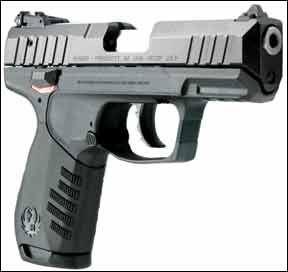
The sights were just fine. The sight picture was perhaps a bit more precise than the Walther’s, because the rear slot was narrower. Getting the gun to hit where we aimed was easier with the Ruger’s fully adjustable rear sight. The Ruger’s front sight was dovetailed into the slide crosswise, and held by friction. We thought that was entirely adequate. There were three white dots.
The SR22 had large ambidextrous safety levers that dropped the hammer when pressed downward to the safe position. The gun could not be carried cocked and locked. Thumb cocking either gun was not easy, the Ruger being harder to cock. Like the Walther, the Ruger had a rail under the muzzle for a light or laser sight.
The overall look of the Ruger was attractive. The anodizing is a bit shinier without being glossy on the slide. The frame is dead black, just like that on the Walther, but the aluminum slide is more of a semi-gloss. Neither gun could be fired with the magazine removed. The Ruger had the odd condition that if the trigger were pressed with the mag removed, the trigger would go rearward and stay there. Inserting the magazine activated the trigger-return spring.
Taking the Ruger apart involved clearing it, then opening a swinging-door-type catch located in (you guessed it) exactly the same place as the one on the Walther. Then (yep!) you pull back on the slide, lift it, and slip it off the barrel to the front. However, the innards of the Ruger were quite different from those of the Walther. The layout and design of the various components were such that we doubt Ruger copied much of the Walther’s insides. Ruger’s mechanical design is a totally different approach to essentially the same external package. As with the Walther, the inside of the gun looked as good as the outside. Reassembly was easier because the Ruger has a shorter, stiffer recoil spring wrapped around a rod of similar length to that of the Walther. Therefore there’s less “threading the needle” involved in getting the gun back together. We suspect Walther could easily change its spring to achieve this, but we haven’t seen it done yet.
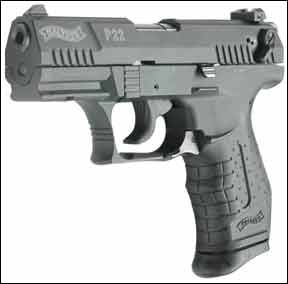
On the range we encountered perhaps the most damning thing about the Ruger, its trigger. It stacked badly in DA mode, breaking at 9.8 pounds, and was creepy in SA mode. Once the 5.5-pound SA pull is learned, it’s possible to do reasonable shooting, but we found it was easier to do that with the smooth trigger of the Walther P22. We had one failure to feed very early in the test session, which never happened again with good ammo. However, both guns refused to reliably function with Federal’s Classic High Velocity ammo, and with our final match-ammo test. (Ruger warned against match ammo in the gun’s instruction manual.) In all cases, the slide was not driven back far enough to pick up the next round. That’s neither a fault of gun nor ammo. Some 22 LR ammo with slower-burning powder works extremely well in rifles, but not so well in short-barrel pistols. Although the Federal ammo got good velocity, its recoil impulse didn’t cycle either gun reliably. Accuracy was so poor we did not record it. Test your ammo, find what works best and gives best accuracy, and you’ll be a happy camper. Ignore this and you’ll curse the gun, the dog, and yourself. We found both guns had distinct preferences for one or another type of ammo.
Does either gun have enough accuracy? We tried a final test on both guns. We cleaned the barrels, and fired ten shots each of Eley Ten-X and Federal Gold Medal Match, two of the finest target loads available. We got into a super-secure, seated, laid-back position and used our Merit aperture sight on our shooting glasses. The Walther put this fine ammo into ten-shot groups of 2.6 inches and 2.8 inches respectively. The Walther did not reliably cycle the Federal Gold Medal Match, and had one failure to feed with the Eley Ten-X. The Ruger, with the same test setup, gave groups of 1.7 inches and 2.3 inches The Ruger also failed to feed both types of match ammo, which we expected.
These guns are not tack drivers. That might be enough reason for a potential buyer to avoid them. We don’t know how to accurize them, or if that’s possible. However, for fun like busting tin cans, these guns are great. They are also viable for training new shooters, or for keeping one’s eye in on rapid-fire shooting of multiple targets, at very low cost. They can provide fun on the trail too, but personally we’d prefer a gun with more accuracy if small-game hunting were on the schedule. As a comparison test, we fired one of our 45 autos loaded with Cor-Bon’s Pow’Rball, and put five into a ragged one-inch hole at the same 15-yard range. That’s the kind of accuracy we hoped for with these 22s but never got.
Our Team Said: We ended up being not so fond of the Ruger. The SR22’s trigger put us off. It annoyed us to much we tried an old gunsmith’s trick on it that helped it a lot. With the gun empty of all ammo, we put lots of thumb pressure on the cocked hammer and pressed the trigger until the hammer fell. We did this a number of times and that took care of some of the creep. If the trigger had been clean and a pound or more lighter, we would have liked the gun better. We found the magazine release to be annoyingly hard to use. Either the buttons need to be longer or the frame needs to be relieved to make it easier to change mags. The Ruger had no problems with feed or function with good ammo. Like the Walther, it ran 100 percent. We did not like the DA trigger at all. We did like the sights, the workmanship, the two extension-type magazine bottoms, the zip case, and the comprehensive manual with its wonderfully detailed exploded view.





























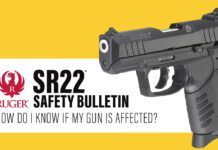
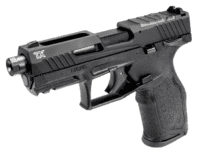

It is perfect time to make some plans for the future and it is time to be happy. I have read this post and if I could I want to suggest you few attention-grabbing issues or advice. Maybe you could write next articles regarding this article. I desire to read even more issues about it!